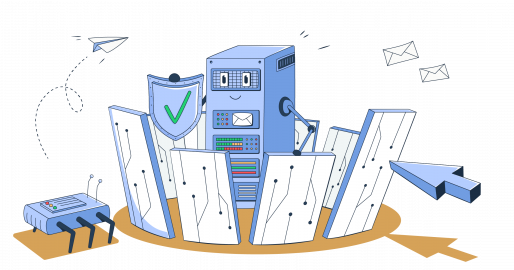In this article, we explain what a secure email server is and how it manages potential threats. You’ll learn how to secure email servers, how to choose a reliable provider, and how server security affects email deliverability.
What is a secure email server?
A secure email server is a server that prioritizes the safety of your email communications using measures like encryption and authentication.
This allows you to transmit confidential messages and documents with confidence. A secure email server protects emails both in transit and after delivery. It also prevents unauthorized users from impersonating your company’s domain and uses spam filters to detect and block suspicious emails.
What makes an email server secure?
Okay, so how exactly do email servers protect your messages? Some of the features of a secure email service include:
- Antivirus and anti-spam filters. These filters scan your emails for malicious emails or attachments, as well as unwanted spam messages.
- Authentication. These mechanisms verify the sender’s legitimacy using protocols like SPF, DKIM, DMARC, and BIMI (more on that later). In addition to these, SMTP authentication and MTA-STS provide further protection for emails in transit. SMTP authentication ensures that only authorized users can send emails through your server, while MTA-STS enforces encryption and validates incoming emails, making it more difficult for attackers to intercept or tamper with them.
- Email encryption. Secure email servers encrypt emails in transit using the TLS protocol to prevent unauthorized alteration, while the PGP protocol secures the content at rest, ensuring only the intended recipient can decrypt and read the message. More about the encryption protocols, how they work and how to encrypt your emails read here.
- Data loss prevention (DLP). This set of mechanisms monitors outgoing emails to prevent the unauthorized sharing of sensitive data. It can block or alert users if emails contain restricted content, ensuring that confidential information stays secure.
- Access controls. Role-based access controls (RBAC) and permissions are necessary to ensure that only authorized users or systems can access specific parts of the server and its resources. This helps prevent unauthorized access to sensitive data.
- Audit logs. Audit logs keep track of everything happening on the server—like who accessed what, when, and what changes were made. These logs act as a helpful record to spot any unusual activity.
- Secure configuration. This means applying the right security settings to your server, including installing security patches and disabling unnecessary services.
The importance of secure email server
A secure email server protects your emails—and the data they contain—from unauthorized access by cybercriminals, who seek to carry out phishing attacks, steal sensitive information or introduce malware to disrupt your systems.
By safeguarding communications between your company and customers, you help prevent data breaches, which can be extremely costly. For example, you could face fines for noncompliance with data privacy laws, such as GDPR, HIPAA, CCPA, and others, or even find yourself dealing with a lawsuit.
In fact, the FBI’s Internet Crime Complaint Center (IC3) reported that business email compromise was the second-costliest type of crime in the US in 2023, with $2.9 billion in reported losses.
But the financial impact doesn’t stop there. If your email server is insecure, it can also seriously hurt your reputation. Customers and clients rely on trust when communicating with your brand, and once that trust is broken—say, by phishing attacks using your email address—they may lose confidence in your company.
Your sender reputation is also at high risk. Without proper email authentication, email service providers (ESPs) like Gmail, Outlook, and Yahoo may flag your emails as suspicious, causing your campaigns to end up in the spam folder. This reduces your open rates, click-through rates, and ultimately, your return on investment.
How to make an email server secure
Here are some best practices for secure email server setup:
Use TLS and SSL protocols
You might have heard of TLS (Transport Layer Security) if your business has a VoIP number and phone system. Similarly, SSL (Secure Sockets Layer) is commonly used to encrypt web traffic. But TLS and SSL are also used to encrypt email data during transit. Configure your email server software to support TLS and SSL, and make sure that TLS and SSL certificates are properly installed.
Apply SPF (Sender Policy Framework)
SPF is a protocol that allows you to specify which mail servers are permitted to send emails on behalf of your domain. It helps prevent unauthorized senders from impersonating your domain in email communications.
To set up SPF, add a DNS record to your domain’s settings that includes a list of authorized sending IP addresses or mail servers.
Watch our detailed video on what SPF is and how to create an SPF record.
Implement DKIM (DomainKeys Identified Mail)
DKIM provides a way to verify the sender’s identity through a digital signature attached to the email’s header. This ensures that the message has not been altered in transit and helps recipients trust that the email came from a legitimate source.
Set up DKIM by generating a public/private key pair and publishing the public key as a DNS record for your domain – use our free DKIM Record Checker to ensure configurations are properly set up. For complete instructions, including use cases and best practices, read this post How to set up DKIM.
Configure DMARC
Domain-based Message Authentication, Reporting, and Conformance protocol works only if SPF or DKIM, or preferably both, are set up.
DMARC provides a way to specify how email receivers should handle unauthenticated emails—whether to reject, quarantine, or take no action. It also lets you get reports on email traffic, so you can spot potential spoofing attempts or unauthorized use of your domain.
To set up DMARC, check out the video tutorial below for a step-by-step guide on how to publish a DMARC policy in your DNS records and define how to handle failed authentication checks. Feel free to use our DMARC Record Checker as well once you’ve finished setting it up.
Set up BIMI
BIMI (Brand Indicators for Message Identification) displays your brand’s logo next to authenticated messages in the inbox to help recipients quickly identify your emails as legitimate.
To set it up, you first need to have DMARC in place with a “reject” or “quarantine” policy. You’ll also need a Verified Mark Certificate (VMC) from a trusted certifying body, like DigiCert or Entrust, and a solid email sending reputation.
However, not all email providers support BIMI. Currently, major providers like Gmail, Yahoo Mail, and ProtonMail do support it, but each has its own set of requirements. More on that here.
Perform a reverse DNS lookup
Reverse DNS lookup is a technique that mail servers use to check whether the sender’s IP address matches a valid domain. When an email comes in, the mail server checks the IP address to see if it’s tied to a real domain and server. If the IP doesn’t map back to a domain, the email could be flagged as suspicious or rejected.
To set this up, you’ll need to ask your email or internet provider to point your mail server’s IP address to your domain name in their DNS records. This way, when someone looks up the IP, it’ll match your domain, which helps your emails look more legitimate and less likely to end up in spam folders.
Set up email firewalls
Email firewalls help protect your email system by filtering both incoming and outgoing messages based on the rules you’ve set for your server. They’re great at spotting things like spam, phishing attempts, malware, and other security threats.
To implement an email firewall, choose a reliable firewall solution that fits your email system. Most email service providers or hosting companies offer built-in firewall features, or you can use third-party solutions like Barracuda, Proofpoint, or Cisco.
Once you have your solution, configure it to filter messages based on your specific needs—such as blocking certain IP addresses, filtering known spam domains, or setting rules for attachments.
Make sure to regularly update the firewall’s filters to keep up with emerging threats.
Manage access control
If you work with a team, you need to implement robust identity security and control who has access to sensitive email data.. Set up permissions based on job roles to make sure only authorized users can access certain parts of your email system.
Many email service providers offer these functionality along with two-factor authentication (2FA) or multi-factor authentication (MFA) to verify their identity with something more than just a password.
Don’t forget to regularly check who has access and remove it as soon as it’s no longer needed, especially when employees leave or change roles.
Apply patches and updates
Keeping your email server secure means staying on top of updates and patches. Cyber attackers love to take advantage of known vulnerabilities, so keeping everything up to date is crucial for protecting your system. Set up a routine for applying updates and patches regularly, and, as part of your overall data backup best practices, make sure to watch for security alerts from your provider to catch any important updates right away.
The role of staff training in secure emailing
As your team grows, it can become more difficult to keep up with all the security standards and requirements. That’s why having a clear company-wide security policy and providing regular staff training is a must. Here are the key steps:
- Make sure everyone with access knows how to identify suspicious emails and avoid cyber threats. To present this information clearly and visually, consider using an AI PowerPoint generator that helps create engaging training materials and presentations for your team.
- Use strong, unique passwords and change any default login information.
- Consider using a password manager to securely store and manage passwords.
- Enhance data security with industrial edge computing (for pros). With this approach, individual user data is stored as near to the source as possible and is processed locally rather than in the cloud. This gives you more control over sensitive information and less exposure to cyber risks, as long as you put strong security protocols in place.
Secure email server providers
When you need to choose a secure email server provider, you have several options depending on your company’s needs and resources. Here’s a breakdown of the most common choices:
Self-managed email server
Opting for a self-managed private email server means you’ll have full control over your email infrastructure, including security measures and data privacy. This option gives you flexibility but also comes with significant responsibility.
Pros: Full control over security, data, and infrastructure.
Cons: The setup and maintenance are complex and time-consuming, which is why many businesses choose third-party ESPs instead.
If you decide to go down the self-managed route, you can choose between open-source options:
- Mail Transfer Agents (MTAs) like Postfix
- Web-based email clients such as Roundcube
- SMTP servers like Haraka
- Apache James (can be used as an SMTP relay or an IMAP server)
or commercial software:
- IBM Notes Domino (this option comes with a license fee but simplifies the setup process)
Third-party email service providers (ESPs)
These providers offer ready-made email solutions, handling server security, maintenance, and updates. Most ESPs also provide SMTP and email API methods, allowing businesses to send emails through their existing systems or integrate email delivery directly into their applications.
However, you have to check the security features they offer, such as encryption, two-factor authentication (2FA), as well as other SaaS Security Posture Management (SSPM) protocols, and compliance with industry standards, to make sure your email infrastructure remains secure.
Pros: Quick setup, reliable service, vendor handles security.
Cons: You depend on the provider for security and functionality.
Popular ESPs include:
- Mailtrap — an all-in-one, budget-friendly email delivery platform for transactional and marketing emails, ideal for developers and marketing teams. It is an ISO 27001 certified platform that supports two-factor authentication (2FA) and is GDPR-compliant. Mailtrap utilizes secure DNS records to protect email data and offers tools for monitoring email performance, testing various email scenarios, and optimizing deliverability. Also, Mailtrap supports email authentication protocols such as SPF, DKIM, and DMARC.
- Gmail for Business.Great for businesses using Google tools. Gmail offers two-factor authentication (2FA), phishing and malware protection, encryption via TLS, robust spam filters, and compliance with GDPR, HIPAA, and other security standards. Gmail also supports email authentication protocols like SPF and DKIM.
- ProtonMail. An ESP with a strong focus on privacy and security. It provides end-to-end encryption, zero-access architecture, and anonymous email sending. ProtonMail is known for its commitment to privacy, with no tracking or logging of user data. ProtonMail supports email authentication protocols like SPF, DKIM, and DMARC.
- Mailchimp — an ESP focused on email marketing. Mailchimp offers two-factor authentication (2FA), encryption of sensitive data, and compliance with GDPR. It also provides email campaign monitoring for suspicious activity and access control settings. Mailchimp supports email authentication protocols like SPF and DKIM.
- Zoho Mail. A reliable email service with solid integration options. Zoho Mail supports two-factor authentication (2FA), encrypted email delivery via TLS, secure access controls, and compliance with various privacy regulations like GDPR. Zoho Mail also supports email authentication protocols such as SPF and DKIM.
You can also consider cloud-based email hosting services like Google Workspace Essentials, Rackspace Email, and Amazon SES—but bear in mind you’ll typically only get basic functionality.
The role of secure email server in email deliverability
When you’re sending out business emails, you don’t want them to bounce back or get marked as spam. If this happens too many times, your IP address could even get blacklisted. A secure email server helps to guard against such problems and make sure your messages get delivered.
Every time you send an email, the servers receiving it will carry out certain checks to verify that the message is genuine. If the email comes from a trustworthy server, the recipient knows that you’ve taken all reasonable steps to keep emails safe.
When your server uses end-to-end encryption and authentication protocols, the receiving server can verify that an email really comes from your domain—and that nobody has tampered with it during transmission. The message is more likely to reach the intended inbox, and your reputation as a sender improves too.
Secure email servers also use a process called “throttling” to control the speed at which you send emails. Without this measure, spam filters may reject your messages because the sudden appearance of multiple emails can seem suspicious.
Plus, if an email bounces because the address is wrong or the recipient’s inbox is full, your email server will record the reason for delivery failure. Then you can troubleshoot your contact list by amending email addresses and removing any invalid ones.
Wrapping up
To keep your email messages private and make sure they’re delivered to their destinations, you need to pay attention to email server security. A secure email server uses encryption and protocols for authentication and verification, detecting and blocking malicious messages and spam.
You can protect your data from common threats like phishing and spoofing by using strong protocols and firewalls, implementing safe usage practices like access controls and regular updates and choosing the best email server provider for your business.



